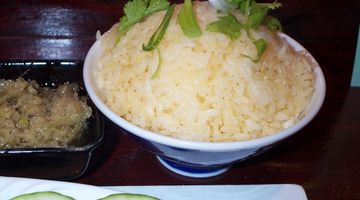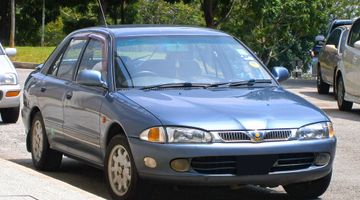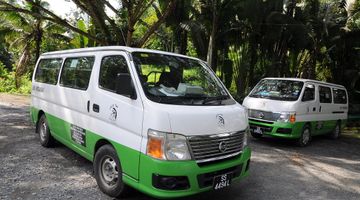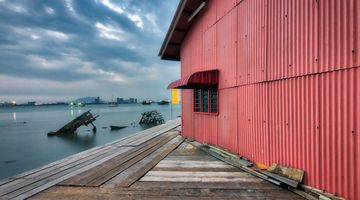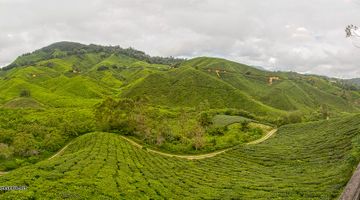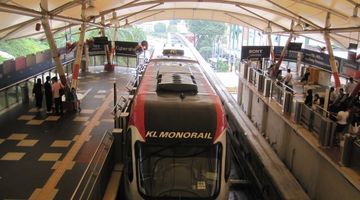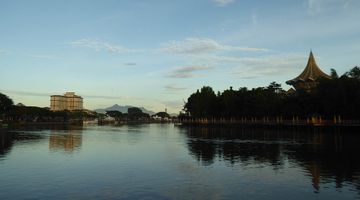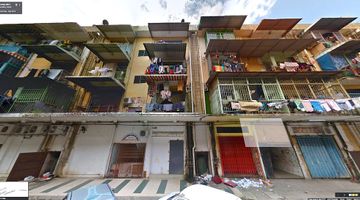Food in Malaysia – Where and What to Eat and How Much It Costs
Malaysia is a foodie’s paradise. The food in Malaysia is delicious, inexpensive and diverse including Indian, Chinese, Malay, and international dishes along with an endless supply of street food. You can order anything from noodle soup or spicy Tom Yam to having traditional Indian food (both vegetarian and non-vegetarian) in a self-service restaurant. Everyone who visits loves the food in Malaysia and you will too.
10 Best local dishes to try
There are lots of different types to choose from. Nasi (rice) and noodles (mee) with meat are popular. Let’s take a look at what to eat in Malaysia and some of the local’s favourites.
1. Nasi Lemak
Nasi Lemak is rice boiled with coconut milk mixed with pandan leaves for fragrance. You typically eat the rice with sambal (a kind spicy sauce), a boiled egg, slices of cucumber and sometimes with fried chicken or rendang (spicy chunks of meat). A handful of peanuts and fried anchovies get sprinkled on the top too. Nasi Lemak is a famous food in Malaysia and often considered a national dish.
2. Roti Canai
Roti is type of fluffy Indian bread similar to pancakes. People usually eat roti with curry, and it rarely costs more than a few ringgits. Other types include roti susu and roti telur. The first is a sweet cooked with condensed milk while the second is fried with egg.
3. Rojak
Rojak has a mixture of chopped fruit and dough served with other ingredients and can be either sweet or savoury. Some eat it as a snack and others for dessert.
4. Assam Laksa
If you like noodle soup, check out Assam laksa. Assam laksa consists of thick rice noodles and mackerel boiled in a mixture of lemongrass and ginger. Shrimp paste often comes as a side. You can find this in restaurants or as street food.
5. Satay (grilled meat on skewers)
Barbequed chicken, mutton or beef in the form of satay with sambal or peanut sauce is a typical kebab-like Malaysian street food. Different stalls have different styles. You pay per stick.
6. Char Kuey Teow
The dish is a type of flat fried noodles served with prawns, eggs, boiled bean sprouts and chives. Expect the noodles to be quite spicy.
7. Roasted Chicken Rice
Roasted chicken gets chopped into chunks of meat and bone. The rice is usually boiled in a chicken broth for taste. A thick soy sauce and slices of cucumber comes with the chopped chicken.
8. Lok Lok
Lok Lok is one of the Malaysian delicacies you’ll see sold along the streets or in a buffet-style restaurant. This involves dipping raw or semi-cooked food into boiling flavoured soup for a few minutes until it’s cooked. Different cities have their own styles and flavours. Some are spicy; others aren’t.
9. Nasi Kandar - Rice with Curry
If you want a local food experience in Malaysia, head to one of the Indian restaurants. You’ll get a plate of either white rice or mildly flavoured rice, similar to briyani and the choice between a selection of curries and sides, which often includes chicken, mutton, prawns, curried eggs and vegetables. Everything is self-service. You get charged for what you eat. Penang is famous for Nasi Kandar.
10. Mixed rice buffet style
This dish is a plate of plain white rice with a 'buffet' selection of sides. Prices are based on the type of food you take. The more sides you have, the more you pay. Indian restaurants are often open 24/7 and only serve halal food. Chinese ones have 'economy' mixed rice and a selection of other non-Halal sides. You shouldn’t pay more than RM 10 ($2.50) for the economy mixed rice and no more than RM 20 ($5) in the Indian restaurants for a massive plate of food with two or three sides. If you want vegetarian food in Malaysia, you can find it at the self-service restaurants.
The five best local drinks to try
Drinking alcohol isn’t as readily available as other parts of SEA and a night out often ends up being expensive. You’ll rarely be able to have a beer with your meal unless you eat in a Chinese restaurant or food court. But, instead, this gives you the chance to sample some of the best Malaysian drinks including their version of iced tea and coffee.
1. Teh Tarik
Teh Tarik is one of Malaysia’s most famous drinks. The name translates to ‘pulled tea’ and refers to a black tea with condensed milk that’s quickly poured from one cup into another multiple times. Pouring cools the temperature and makes the top frothy. You can find this drink in most Indian shops. It should cost less than RM 3 ($0.70).
2. Teh ice
Teh ice is milky tea with ice. This is the second most popular drink in Malaysia after Teh Tarik, and you’ll often see people sipping it in Indian restaurants.
3. Neslo (often served with ice)
This drink is a combination of Nescafe (coffee) and milo. Milo is a popular chocolate drink in Malaysia. This drink is like the Cafe Mocha drink in the western or European countries. You can drink this hot or with ice.
4. Milo Dinosaur
Despite the unusual name, Milo Dinosaur is a famous drink in Malaysia. A double serving of Milo gets mixed with boiling water to give a very rich tasting drink.
5. Cendol (pronounced Chen-dol)
If you travel around Asia, you’ll notice some people with drinks that contain small, colourful jelly-like cubes at the bottom. This jelly is cendol, and the drink has a mixture of coconut milk and syrup to create a thick, sweet drink.
Food prices
The Malaysian food prices are inexpensive compared to western and other SEA standards. A meal at a local restaurant rarely costs more than a few dollars for a generous serving. If you eat with the locals in Kuala Lumpur, expect to pay no more than RM 10 ($3) for a simple dish, bowl of soup, or plate of fried rice or noodles. The Nasi Kandar and self-service restaurants are very affordable too with a huge plate of rice and sides rarely exceeding RM 20 ($6). Street food is even cheaper.
Some stalls serve Nasi Lemak for takeaway in either a polystyrene container or plastic bag for just a few ringgits (less than $1). Others have 'goreng-goreng', a mixture of deep fried dough snacks, for an equally inexpensive price.
The Indian Banana Leaf restaurants where the food comes on a banana leaf rather than a plate, often has a free flow of rice and sides. This type of food may cost around RM 20 ($5) per person depending on the restaurant and location. Western food in Malaysia is more expensive. Pizza, burgers and spaghetti would cost anywhere between RM 15 ($3.60) and RM 50+ ($12) with most prices towards the higher end of the spectrum.
Another type of food in Malaysia is steamboat. The concept is that you pay for a soup base and have a buffet of different types of food including meat, fish, prawns, squid, vegetables and tofu to cook in the boiling soup. Depending on the location, expect to pay up to RM 50 ($12) per person excluding drinks.
One thing worth mentioning in Malaysia is the price of food varies depending on your location. Sarawak has lower prices for the same portion compared to Kuala Lumpur. A meal is likely to come to less than RM 4 ($1) compared to RM 10 ($2.40). Prices in Sabah are on par with those in Kuala Lumpur. Penang has a reputation for producing some of the best Malaysian food, which you can enjoy in one of the many food courts.
Food security
Malaysian food is generally safe, although you may experience stomach problems in the first day or two. If you eat at the more expensive restaurants, the Malaysia food security will be very high, and you’re unlikely to experience any problems. These establishments often include the ones with an air-conditioned eating area.
Smaller local restaurants can be hit or miss, but generally won’t cause any problems. A typical Indian restaurant displays their food on the shelf near the entrance for customers to choose their own sides. Eating from here is perfect around lunchtime when they’re fresh. Though it may not be such a good idea later in the evening after being in the tropical heat for hours. The same is true for Chinese buffet-style restaurants.
Smaller street-side ones and street food can be more risky. More often than not, you’ll see them near a drain where they can pour the excess water and oil, which mean the area isn’t the most hygienic. Be cautious and use your own judgement as to whether the food will be OK to eat. If in doubt, don’t eat there.
Other things to mention are the spiciness and use of MSG. Many dishes come with chopped chillies in a small bowl with soy sauce. You have the choice to eat it with your meal. Indian curries often use chilli, and the same goes for the sauce on some of the other dishes in both Chinese and Indian restaurants. The use of MSG is very common for cooking in Malaysia, and those with allergies should take extra care.
Best restaurants to dine
Malaysian food culture is all about finding and enjoying a delicious meal regardless of the environment. This means many of the recommendations from Malaysians won’t be Michelin-Star restaurants but rather food courts or Mamaks.
Food courts
A food court is a large number of individual food stalls inside an open space giving you the freedom to choose from a selection of dishes. You tell the stall what you want, and they’ll bring the meal to your table where you then pay. Someone selling drinks will approach your table.
Mamak Stall (Indian Muslim restaurants)
The Mamaks’ have typical Indian halal food, and you can have Nasi Kandar, roti and other types of curry, meat and seafood here. This kind of restaurant is on almost every street in every city in Malaysia. Ask your hotel for a recommendation.
Jalan Alor in Bukit Bintang Area
Jalan Alor is a street lined with hawkers serving a variety of Malaysian food in the touristy area of Kuala Lumpur. Expect foreigner prices, especially aimed at the wealthy Arab tourists. Locals find the food here to be expensive, but you have a lot of choices including Malaysian, Arabic and western styles of dishes. The Arabic food, such as chicken mandi is worth the relatively high cost.
Street Food
Street food gets sold in most places and ranges a portion of Nasi Lemak to satay sticks. Pisang Goreng, or deep fried bananas, are always a delicious treat. Just use your intuition to assess the stall’s level of hygiene before you buy.
Learning to cook Malaysian food
Ask any tourist their favourite part of their trip, and many will mention the food in Malaysia. So, why not learn how to cook and bring a little bit of Malaysia back home with you at one of the following schools?
1. The Cooking House
The Cooking House in Kuala Lumpur teaches students how to prepare typical Malaysia dishes over the course of six weeks. Each weekly lesson lasts four hours and covers everything from steamed chicken to curries along with teaching you how to adapt meals to suit your tastes. Lessons cost RM 190.80 ($46) per lesson or RM 932.80 ($225) for the whole course. If you’re here on holiday, drop by and join a single lesson for a new experience. Otherwise, the class is geared more towards expats.
2. At 19 Culinary Studio
Culinary Studio in Kuala Lumpur offers lessons for people of all levels of abilities in a warm and friendly environment. The home kitchen provides the perfect setting to learn how to prepare dishes and meet other tourists, expats and locals in their small class. Everything from the basic concepts of Malaysian cuisine up to advanced techniques and seasoning get taught. Expect it to cost around RM 175 ($42) per person.
3. Private classes
If you don’t want to attend a school, there are other options available such as joining a private class with a local host. A typical lesson includes a trip to the market to buy fresh ingredients along with a detailed description of the cooking process. You’ll later learn how to cook in the host’s kitchen. Viator has a selection of workshops with prices starting from $30 per person.
Conclusion
The food in Malaysia is probably the highlight of visiting the country. A range of cuisines and styles are accessible in all cities, and Malaysia food prices tend to be very inexpensive. And if you love the food so much, why not join a cooking class and bring a small part of the experience back home?
